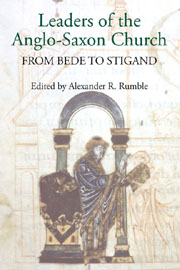Book contents
- Frontmatter
- Contents
- List of Illustrations
- Preface
- Contributors
- Abbreviations
- Introduction: Church Leadership and the Anglo-Saxons
- 1 Bede and the Early English Church
- 2 Archbishop Ecgberht and his Dialogus
- 3 Abbatial Responsibility as Spiritual Labour: Suckling from the Male Breast
- 4 Understanding the Earliest Bishops of Worcester c. 660–860
- 5 The Role of Bishops in Anglo-Saxon Succession Struggles, 955 × 978
- 6 Image-Making: Portraits of Anglo-Saxon Church Leaders
- 7 ‘To Keep Silence Following the Rule's Command’: Bishop Æthelwold, Reforming Ideology and Communication by Signs
- 8 Wulfsige of Sherborne's Reforming Text
- 9 From Winchester to Canterbury: Ælfheah and Stigand – Bishops, Archbishops and Victims
- Index
9 - From Winchester to Canterbury: Ælfheah and Stigand – Bishops, Archbishops and Victims
Published online by Cambridge University Press: 05 February 2013
- Frontmatter
- Contents
- List of Illustrations
- Preface
- Contributors
- Abbreviations
- Introduction: Church Leadership and the Anglo-Saxons
- 1 Bede and the Early English Church
- 2 Archbishop Ecgberht and his Dialogus
- 3 Abbatial Responsibility as Spiritual Labour: Suckling from the Male Breast
- 4 Understanding the Earliest Bishops of Worcester c. 660–860
- 5 The Role of Bishops in Anglo-Saxon Succession Struggles, 955 × 978
- 6 Image-Making: Portraits of Anglo-Saxon Church Leaders
- 7 ‘To Keep Silence Following the Rule's Command’: Bishop Æthelwold, Reforming Ideology and Communication by Signs
- 8 Wulfsige of Sherborne's Reforming Text
- 9 From Winchester to Canterbury: Ælfheah and Stigand – Bishops, Archbishops and Victims
- Index
Summary
THE final chapter of this book on leaders of the Anglo-Saxon church reconsiders the lives and contrasting reputations of two late Anglo-Saxon bishops of Winchester, both of whom were subsequently promoted to be archbishops of Canterbury. One (Ælfheah) was a monk who was later canonized as a martyr, the other (Stigand) was a secular priest who was vilified even before his death as a pluralist and a usurper. Each played an active part, as advisers to the current king, in important national events. Both of them eventually died as the result of invasions of England from the Continent. Both are mentioned in contemporary accounts and documents, but their reputations were however mainly fossilized after the Norman Conquest when chroniclers assessed their lives in accordance with monastic and papal ideals of behaviour.
Ælfheah of Winchester and Canterbury
Ælfheah was born c. 953 and appears to have had the byname Godwine, probably a patronym. He seems first to have lived as part of the clerical minster at Deerhurst, Gloucestershire, before moving south to Somerset and there associating himself with the monastic reform. According to William of Malmesbury he was at some point monk and prior of Glastonbury Abbey. However, according to Osbern's late-eleventh-century Vita Sancti Aelfegi, upon leaving Deerhurst he is said to have dwelt as a hermit at Bath, before joining (or refounding) the reformed monastery there. He became abbot by 982, probably c. 977, in succession to Æscwig with whom he may already have shared some authority since 968.
- Type
- Chapter
- Information
- Leaders of the Anglo-Saxon ChurchFrom Bede to Stigand, pp. 165 - 182Publisher: Boydell & BrewerPrint publication year: 2012



